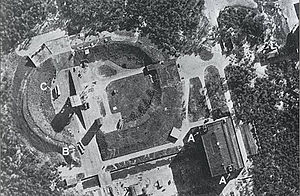Konrad Dannenberg
Konrad Dannenberg | |
|---|---|
University of Hannover | |
| Occupation(s) | Rocket engineer and designer |
| Spouses |
|
| Children | 1 |
Konrad Dannenberg (August 5, 1912 – February 16, 2009) was a
Early years
Dannenberg was born in
Dannenberg was a member of the
Career
In the spring of 1940, through the influence of Püllenberg, Dannenberg was discharged from the army and became a civilian employee at the Heeresversuchsanstalt Peenemünde (
After the end of World War II, Dannenberg was brought to the United States with 117 other German specialists under

In 1960, Dannenberg joined NASA's newly established Marshall Space Flight Center as Deputy Manager of the Saturn program.[1] He received the NASA Exceptional Service Medal in 1973 for successfully initiating development of the largest rocket ever built, the Saturn V, which took the first human beings to the moon.[1]
When
Post-retirement
Dannenberg retired from the Marshall Space Flight Center in 1973 and became an associate professor of aerospace engineering at the University of Tennessee Space Institute (UTSI) in Tullahoma, Tennessee.
Dannenberg was a Fellow of the American Institute of Aeronautics and Astronautics and past president of the Alabama/Mississippi Chapter of this organization. In 1990, he received the prestigious DURAND Lectureship, and in 1996, the Hermann Oberth Award.
He lectured on basic rocketry at the
He was a member of the NASA/MSFC Retirees Association, an honorary member of the Hermann Oberth Society of Germany and a charter member of the L5 Society, which is now the National Space Society (NSS). In 1992, the
-
One of 18 units that was part of a rocket engine combustion chamber that Dannenberg helped to design.
-
In the Historisches Museum Hannover, Dannenberg stands next to a Püllenberg R-7 rocket that he helped design.
-
Dannenberg talks with Scaled Composite's founder, Burt Rutan.
Personal life
He was married to Ingeborg M. Kamke, and had a son, Klaus Dieter, who has two married children. From them Dannenberg had four great grandchildren. He had remarried to Jacquelyn E. Staiger of Kingston, Massachusetts. Dannenberg died in Huntsville on the morning of Monday, February 16, 2009, at the age of 96. He is buried at Maple Hill Cemetery (Huntsville, Alabama).[6]
References
- ^ a b c d Dale, Daniel (February 21, 2009). "Konrad Dannenberg, 96: Rocket scientist behind the moon landing". Toronto Star.
- ^ Miller, Stephen (February 21, 2009). "His Rockets Flew in War and to Moon". The Wall Street Journal.
- ^ Aviation Week & Space Technology, 23 February 2009, "Obituaries", p. 20
- ^ a b Pearce, Jeremy (February 23, 2009). "Konrad Dannenberg, 96, Top Rocket Scientist, Dies". The New York Times.
- ^ National Geographic (2005). "The Hunt for Hitler's Scientists". Retrieved July 17, 2012.[dead YouTube link]
- ^ a b Cumbow, Victoria (February 16, 2009). "Konrad Dannenberg, space pioneer, dies at 96". The Huntsville Times.
- ^ WvB FBI file
- ^ Radford, Tim (July 2, 2009). "The First Man On The Moon". The Guardian. London.
External links
- "Reach for the Stars". TIME Magazine. February 17, 1958. Archived from the original on December 21, 2007.
- Dunn, Marcia (July 19, 1999). "Old and overlooked, but still passionate about space". The Topeka Capital-Journal.
- Bryan, Dave (August 13, 2002). "Remembering Wernher von Braun's German Rocket Team". Space.com.
- Rincon, Paul (September 7, 2004). "V-2: Hitler's last weapon of terror". BBC News. (includes Dannenberg interview)
- Marconi, Elaine M. (December 19, 2006). "Legendary Rocket Pioneer Visits Kennedy". NASA's John F. Kennedy Space Center.
- Wade, Mark. "Biography of Albert Püllenberg". Encyclopedia Astronautica. Archived from the original on 2007-12-30.
- Wade, Mark. "Biography of Konrad Dannenberg". Encyclopedia Astronautica. Archived from the original on 2007-04-10.
- "Dannenberg, Konrad D., November 7, 1989; Peenemünde Interviews Project". National Air and Space Museum, Archives Division. Retrieved August 31, 2010.
- Konrad Dannenberg Collection, The University of Alabama in Huntsville Archives and Special Collections



